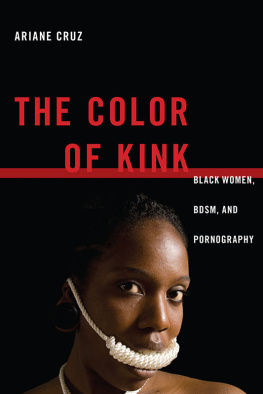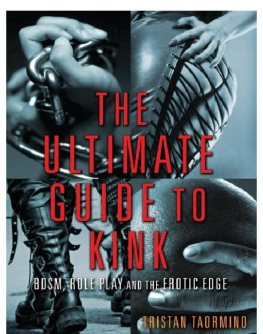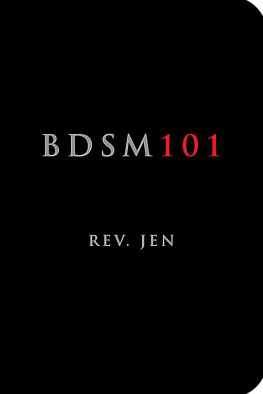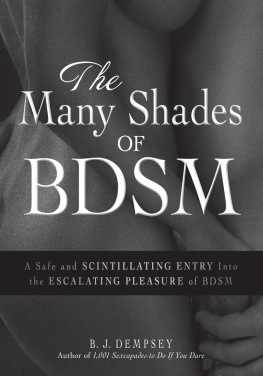Dedicatedto the BDSM Communities for changing the public dialogue about sex and gender, andwith gratitude for their support and friendship.
Introduction

Its 1993, and Im sitting in the ChiefEditor of Psychology Todays office with Will Brame, my husband of now26 years and creative collaborator. Our book, Different Loving, was aboutto be released. After much resistance and scoffing from mainstream outlets aboutreviewing a book on BDSM culture, our publicist Sharyn landed us an in-person meetingwith a psychologist who we hoped would take our work seriously.
Sharyn had worked tirelessly to getus on a talk show or nail down the promise of a review in a respected print publication.When a producer from the Phil Donohue show reluctantly agreed to meet us for lunch,they insisted Sharyn be there, presumably to protect them against scary whip-wieldingsex perverts. When we showed up dressed in business clothes, the producer admittedshe was disappointed by our normal appearance and passed on us. We didnt fit theirexpectations of social freaks - they didnt know what to do with us.
The review copies keep disappearingat The New York Times, Sharyn said, but then they act like they are toogood to review you. Do you know what someone at the New York Review toldme? They said it was too heavy to read one-handed!
We laughed at prudery, false morality,and sexual ignorance but it hurt anyway. After intensively researching the psychiatric,psychological and historical literature about sadomasochistic and fetishistic sex,we knew that most sex theory on paraphilia (so-called abnormal sex) was largelyFreudian and distinctly unscientific. When we interviewed psychiatrists who specializedin paraphilia, we quickly realized that most of them still viewed people like usas pathological based solely on the type of sex we liked.
We knew wed written a book that wasworth paying attention to, if only because we had effectively made the first evidence-basedcase to demonstrate that so-called sexual perversion was an invention of perverted19th century Victorian men. People who enjoyed exotic acts like whipping,erotic spanking and bondage, or who liked to dress in fetish wear or use clothingto express an internal rather than immediately visible identity were not mentallyill, criminal or morally corrupt. They were as normal as anyone else. The problemwas that only people like us knew that at the time, while the world continued tobelieve outdated psychiatric theories.
I knew what to expect when I signedon to write a book about my forbidden sexual identity and people who shared it.I knew it probably spelled the end of my life in the elite New York circles of poetsand writers, and that my career as an English professor was over. More than that,I figured there would be lots of people snickering over me, and that it might beharder than ever to be taken seriously by anyone because that was the power of thetaint in 1993 when a person like me came out as kinky. Ill save the story of howI came to make the choice to throw chance to the wind in a future memoir. For now,suffice to say, I just knew that someone had to tell the truth about kinky people.
And for one shining moment, sittingin that editors office, I hoped academic acceptance and interest might help turnthe tide of mainstream media censorship. Then the door opened, and a stout and sourwoman strode in, sniffing as if there was an unpleasant new smell in her office.She sat behind her desk and stared sternly down her nose at us, shuffling a pileof papers to let us know she was busy. No time for polite conversation.
How could you call this loving?she said. These are sexual aberrations! Theres no love involved.
I gripped my husbands hand, and wetried to explain how wrong she was. Since I was still years away from becoming asexologist, she saw us as BDSM apologists, not credible authorities. Then, justas abruptly, the interview was done and we were dismissed. Maybe she sprayed a littleBDSM-room freshener when we left, I dont know.
Twenty-two years later, we can answerall the doubters and anti-BDSM people with authority: BDSM is as loving as any othertype of consensual human intimacy. This follow-up volume to our original classicis devoted to that growing body of evidence, and the happy lives, long-term committedrelationships, daily realities, and lively communities that make us Different Lovers.
21st century BDSM
The letter code BDSM was conceived asan umbrella term to cover three related models of kinky relationships. It was hopedthat a single, overarching term would allow practitioners to form fellowship overcommonality instead of bickering over differences.
Bondage and Discipline (B&D), relationshipsor role-play involving bondage and punishment scenarios.
Dominance and Submission (D&S),relationships or role-play where one person leads and the other follows, also knownas power relationships.
Sadomasochism (SM), the acronym forsadism and masochism is commonly applied today to people who are not interestedin romance or power dynamics but enjoy giving or receiving intense sensation.
BDSMers may be any of the above or acombination of the three. They span the gamut, from hedonists who occasionally enjoypain-play without a power dynamic, to fetishists who crave sensual, power-basedplay, to lifestylers permanently committed to master/slave relationships. As longas the people feel comfortable describing themselves as BDSMers, they are acceptedas BDSMers in the BDSM community.











